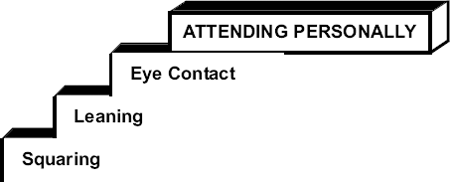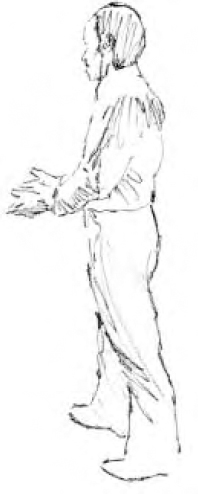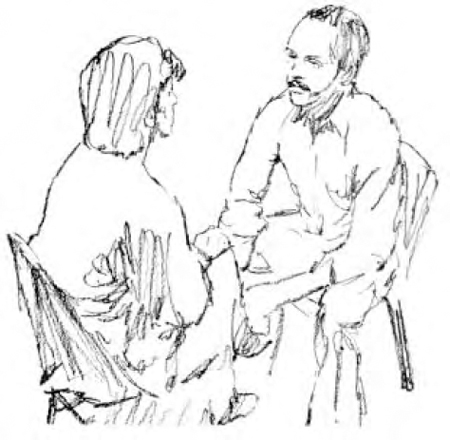By attending personally we bring our helpees into close proximity with us. In so doing, we communicate our interest in the helpees. Communicating an interest in the helpees tends to elicit a reciprocal response of interest from the helpees.
Attending personally involves posturing ourselves to give our full and undivided attention to the helpees. Attending personally emphasizes facing the helpees fully by squaring with them, leaning forward or toward them, and making eye contact with them. Attending personally to the helpees prepares us for observing them fully.

ATTENDING PERSONALLY
One way of posturing ourselves to attend to the helpees is to face them fully. Whether standing or sitting, we may attend to an individual helpee by facing him or her squarely— our left shoulder to the helpee’s right shoulder and vice versa. When we are dealing with a couple or a small group of people, we should place ourselves at the point of a right angle drawn from the people to our extreme left and right. See how differently we feel about the helpees when we posture ourselves in this manner rather than posture ourselves primarily for purposes of our own comfort.

SQUARING
There are other ways of posturing ourselves to attend personally. The inclination of our bodies is another critical way. For example, when we are sitting we attend most fully when we incline our bodies forward or toward the helpees, to a point where we can rest our forearms on our thighs. When standing, we attend most fully when we close the physical distance by moving closer to the helpees. Putting one leg in front of the other will help us to lean slightly toward the helpees.
There are still other ways of attending to people in need of help.

LEANING
We must seek in every way possible to communicate our full and undivided attention. Perhaps the key way of attending personally involves how we use our senses, particularly our eyes. We communicate attentiveness when we maintain eye contact with the helpees. The helpees are aware of our efforts to make contact with them psychologically through our efforts to make contact with them visually.

MAKING EYE CONTACT
We may rate our level of “personal attending while sitting” by using the following scale.
| High attending |
— Squared, eye contact, and leaning 20 degrees or more |
| Moderate attending |
— Squared, eye contact |
| Low attending |
— Not squared, slouching |

LEVELS OF PERSONAL ATTENDING WHILE SITTING
Clearly, we do not always attend personally by sitting. Often we are attempting to help people while standing. We can use a similar scale to rate our demonstration of the skills while standing.
| High attending |
— Squared, eye contact, and leaning 10 degrees |
| Moderate attending |
— Squared, eye contact |
| Low attending |
— Not squared |

LEVELS OF PERSONAL ATTENDING WHILE STANDING
We communicate personal attending by all of our mannerisms and expressions. When we are nervous and fidgety, we communicate a reluctance to be there. When we are intense but relaxed, we communicate attentiveness. When we are consistent in attentive behavior, we communicate interest. When we blush or turn pale, we communicate different levels of reaction to the helpees. It is important to have ourselves “together” in attending behavior.
We can practice our own attending posture, first in front of a mirror and then with people we see in everyday life, to whom we want to communicate interest and concern. We may feel awkward at first; after awhile, however, we should notice that we focus more upon the other person and that the other person is more attentive to us.
Perhaps the most important skill that personal attending prepares us for is observing.
COMMUNICATING INTEREST— CONSISTENT ATTENTIVE BEHAVIOR
